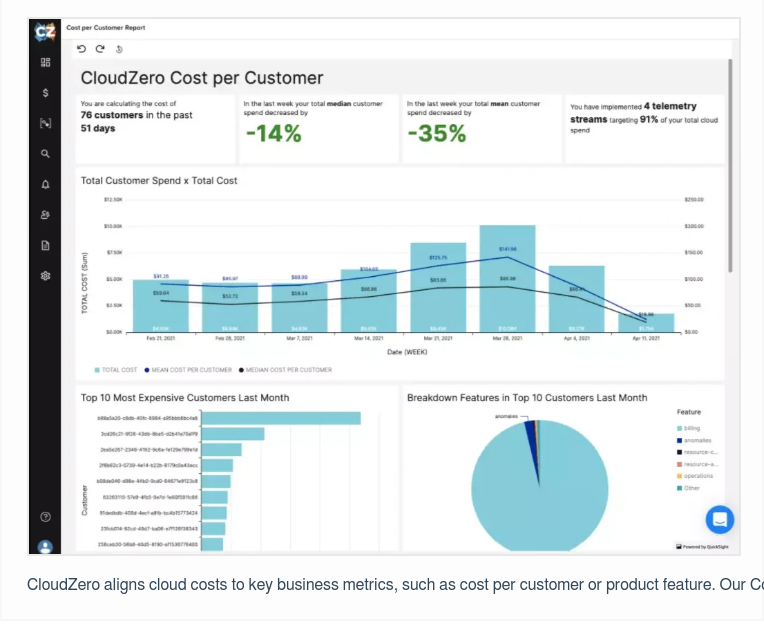Just as there are a handful of stages to describe the financial journey from startup to established company — pre-seed and seed funding, followed by series A, B, and C funding — there are also stages to the process of achieving a healthy understanding of your costs. We at CloudZero like to call these cost intelligence maturity stages “crawl,” “walk,” and “run.”
Both the venture stages and the cost intelligence journey require you to start with the basics and move through each level only after you’ve built a strong foundation at the previous level.
Understanding unit economics, by means of tracking and analyzing unit cost metrics, is how you build that foundation for cost intelligence.
At the end of the day, unit economics comes down to maximizing profitability (or growth when you reinvest those gains back into the business!). When you understand how your cloud spending affects your business objectives, you can uncover which parts of your infrastructure are profitable (or not profitable, in some cases).
Most businesses find that funding stages and cost intelligence stages easily go hand-in-hand. If a fledgling organization hasn’t secured much funding, it’s unlikely it has put much focus yet on maximizing profitability through unit economics. An established organization, meanwhile, will be much more concerned with profits and should therefore have a stronger unit economics strategy in place.
However, it’s possible your business may be at a different stage of funding and cost intelligence. An established company may have secured a few rounds of funding, for example, before it begins nailing down unit costs and using that knowledge to become more cost intelligent.
Interestingly, companies that place an emphasis on unit cost considerations earlier rather than later could set themselves up for success through a deeper understanding of their market fit, pricing schemes, and other important factors that help with securing future funding rounds.
Conversely, companies that blindly push forward without a cost intelligence strategy risk running into some major problems down the line.
Let’s take a look at which aspects of unit economics should be your focus throughout your company’s funding progression.
Seed Stage
In the seed stage, you’ve just received the earliest round of funding for your new business. At this point, you’re likely more concerned with developing and launching your product than about maximizing your eventual profit margins. But it never hurts to optimize early.
Tracking metrics at the seed stage will give you insight into the needs of your first few alpha or beta customers and how they might be using your product to solve problems. User data is the key to understanding if you have product market fit, if your early customers are enjoying your product, or if they stop using it shortly after trying it out.
Generally, during the seed stage, you’ll be tracking things such as:
- How many customers have chosen to use your product?
- What is the problem those customers are trying to solve?
- How long, on average, do customers continue using your product?
With an eye toward the future, you can also track some early “crawl stage” unit cost metrics:
- How much did it cost to develop your prototype, or a minimum viable product?
- How much does it cost to deliver this product to your customers?
- How much are your early customers paying for this product?
Growth and education should come first. Rather than going for pure profits right away, direct your efforts toward improving your product based on the feedback you’ve gathered.
Your cost intelligence will primarily be in the “crawl” phase here, where you’re learning what your product costs and what kind of revenue it can bring in. But as you approach a point where you’re ready to go for series A funding, think about transitioning to a “walk” phase of cost intelligence at the same time.
By this point, you should understand your early metrics fairly well, and you can begin to make your first optimizations.
Series A
Series A funding comes after your business has established a user base and a reliable revenue or achieved another similar KPI. You may not, however, have settled on your pricing and packaging tiers, and you likely also still have some wiggle room in your overall business direction.
Now is the time to put your first tracked metrics to use. The unit costs you have been measuring up until this point should form the basis for your pricing and packaging strategy. They can also guide your future product development decisions.
Though you may have been willing to lose some money in your earliest stages in exchange for getting your first product into the hands of your alpha customers, you can’t continue that trend for very long. So, the focus here should be primarily on tracking your costs per customer.
Doing so now instead of waiting for future venture stages can save you from making some extremely costly mistakes later on.
If you don’t understand your costs per customer, you might end up pricing your product in a way that sets you up for long-term failure because your profit margins will be forever hobbled. Without ensuring you have a good margin, you risk building a business that will never be profitable.
Series B
By the time you’ve reached series B, you may feel as if you’ve hit your stride in terms of understanding your business and its potential. You’ve talked to your customers about their needs, focused your company around the needs you want to fulfill, and started to bring customers onto your platform and achieve some growth.
You might even be starting to get some ideas about ways to further expand or hone in on a particular customer profile, based on the information gathered by tracking your costs per customer. In other words, you feel comfortable strolling along in the “walk” phase.
Anytime you feel comfortable, that’s a sign that it’s time to reach for more.
Think about some questions you’d like to be able to answer. Yours will vary, but here are some ideas:
- How does your product perform in America compared to other countries?
- How could you group products or packages together to maximize profitability for your company?
- Could you also shift packages around to make them more useful to your desired customer profile?
While you may have primarily been tracking costs per customer so far, you can now take that one layer deeper. For example, what are your costs per customer per product? Or per feature? Per user location?
The more you can drill down into the details, the better you will be able to understand how your products and features are being used and how your customer usage is ultimately driving your costs. From there, you can refine your pricing and packaging to benefit your company and your customers.
Series C
Your company is established, your market and your customers have experience with your product, and you know where you are and where you’d like to go. Now, you can “run” with your cost intelligence strategy.
Since by now you likely have a good understanding of your current situation, you can turn your attention to the future.
Using your past and present unit costs to forecast future costs isn’t an exact science, but with practice you can certainly derive some useful estimates of what you’ll need to budget or raise for future funding.
You can easily make simple predictions of how much it might take to develop a new product or feature based on your previous development costs. But in cloud-based environments, usage is truly what drives costs.
The most useful forecasts will tell you what would happen if certain factors affect customer usage in the future. These factors could be anything from the release of a free product trial to the availability of new technology that makes your products run more efficiently in the cloud.
Perhaps the most common scenario that affects usage is simply the growth of your company.
- What are your plans to bring on new customers?
- What will be the cost of this new customer acquisition? If you’re using an ad campaign, for example, what will the advertisements cost?
- What is the estimated lifetime value, or total expected profit, for each new customer?
- Will the costs or profits change as your business scales up, or will they stay fairly stable after a certain threshold?
- How can you consistently keep your profits greater than your costs as your business grows?
Running these forecasting calculations before each major business decision is crucial.
Huge, strategic maneuvers have the potential to cripple a business if they’re based on faulty assumptions, so you’ll want to rely on detailed, accurate data to inform your decisions. And the most accurate data comes from meticulously tracking as many unit cost metrics as you can.
Ready To Stop Crawling And Start Walking Or Running? CloudZero Is Here To Help
If you run a startup, you might be wondering about the best time to get started tracking unit costs. If you haven’t yet built your first product and you have no costs or revenue to track, this is the only time you can get away without having a cost intelligence strategy.
As soon as you’ve begun building your core product and accumulating costs, it’s critical to track everything to make sure your company comes out financially healthy at the end of the process. However, it’s not always easy to know what to do and when to do it when you’re also worried about building a product your future customers will love.
CloudZero’s cloud cost intelligence platform takes the confusion out of tracking and analyzing your costs and revenue. Using the combination of our intuitive platform and an expert team standing by to help, you can have your first clear picture of your unit economics — and be able to make informed business decisions — in just a few hours.
 to see how quick and convenient unit cost tracking could accelerate your progression through each major stage along your company’s journey.
to see how quick and convenient unit cost tracking could accelerate your progression through each major stage along your company’s journey.










